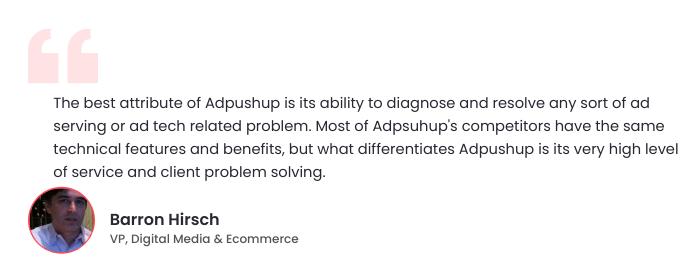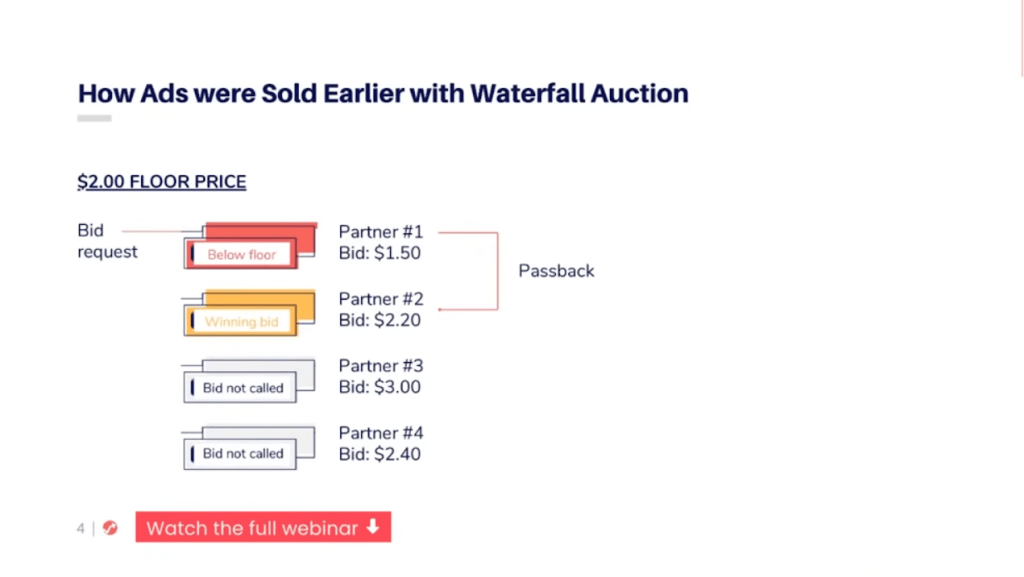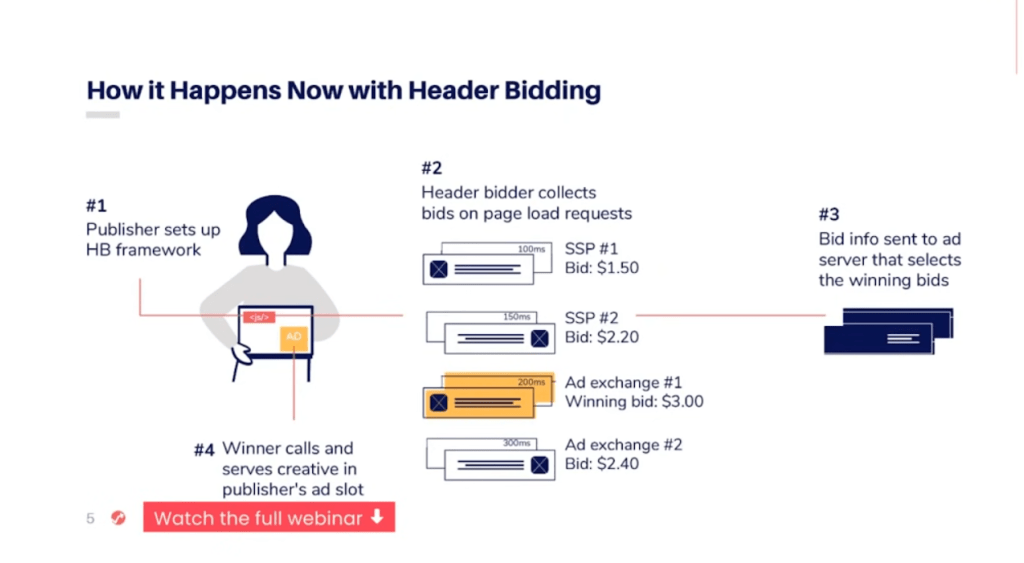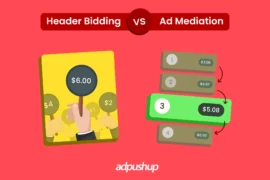Programmatic display advertising (PDA) has changed the advertising game altogether. What required back-to-back negotiations and human interventions can now be done within seconds with the help of technology. So, what is programmatic display advertising, and how it differs from traditional display advertising? Let’s find out.
The world of programmatic advertising is plagued with jargon, which can sometimes make even the simplest of things sound complicated. Many times, these jargons can even confuse the veterans of the programmatic advertising world. At its core, it’s simply the process of buying and selling ad space using technology. And in this blog, we will shed light on how it’s done through programmatic display advertising.
Whenever you visit a website, you will come across ads at certain places on the webpage. It can either be on top, left or right side, or in-between the page content. We call them display ads, and if the ad is displayed using technology instead of human negotiations, we call it programmatic display ads. The whole process of buying and displaying ad space across websites is called programmatic display advertising. This ad format is rapidly gaining popularity.
In fact, the ad spend on programmatic display advertising in the USA alone would have touched USD 157.35 billion in 2024. Moreover, programmatic display ad spending will grow three times the non-programmatic display ad spending rate at 15.9%.

In this blog, we will cover everything about programmatic display advertising – what it is, how it’s done, the difference between other forms of advertising, and how you can benefit from it.
What is Programmatic Display Advertising?
Before we jump to defining programmatic digital advertising, there are two major terms you should familiarize yourself with – digital advertising and programmatic advertising. While both might sound familiar, both have their distinctions.
Programmatic Display Advertising Definition
Programmatic display advertising is the buying and selling ad inventory for display ads by applying advanced technology-based solutions like AI, algorithms, or machine learning. In simple terms, it is buying ad space on a website and placing display ads to users using machines and software.
Now, to understand its meaning thoroughly, there are certain terms that you will need to understand:
- Programmatic
- Programmatic Advertising
- Display Ads
- Programmatic Display Ads
What Does Programmatic Mean?
When you Google the word programmatic or program, it shows:
“a series of coded software instructions to control the operation of a computer or other machine.”
In simple words, programmatic means automated control of a process.
What Is Programmatic Advertising?
Programmatic advertising is a new-age revolution in the advertising world that has opened up a horizon of possibilities for both publishers and advertisers.
In digital marketing, it means using automated technology to buy and sell ad inventory or media (ads). It has made digital advertising more streamlined, efficient, and global. It deals in various kinds of ads like display ads, native ads, in-stream video ads, audio ads, etc.
It becomes programmatic display advertising when the ads in question pertain only to display ads. Simply put, the dealings for ad space will only occur for showing display ads on the publisher’s website.
What are Display Ads?
As opposed to programmatic display ads, the display ads, also called banner ads, are one of the oldest and most established ad formats used in digital advertising. They are generally static in nature and often appear in the form of videos, gifs, images, or interactive multimedia to engage your user.
These traditional display ads are generally placed manually on a publisher’s website, i.e., there is no use of technology like real-time bidding in buying and selling ad space for these ads. However, when display ads are bought using technology, they become programmatic display ads.
Types of Display Ads
An advertiser can use many types of display ads based on their product and target audience. Some of them are:
- Static ads
- Animated ads
- Rich media ads
- Sticky ads
- Dynamic ads
And the list goes on.
Programmatic Display Ads
Programmatic display ads are display ads that are placed on a publisher’s website using AI-based software. Technologies like real-time bidding and header bidding are used to buy and sell ad inventory for these ads.
What is Programmatic Advertising vs Non-programmatic/Traditional Advertising?
Simply speaking, programmatic advertising is an evolved version of non-programmatic advertising, also called traditional or manual advertising. What differentiates them is their approach to advertising and audience targeting. The former emphasizes targeting the right audience, while the latter focuses more on ad placements (location of the ad on a platform). Many more aspects differentiate the two, such as:
| Aspect | Programmatic Advertising | Non-Programmatic/Traditional Advertising |
| Buying Process | Automated real-time auctions with algorithms and tech platforms. | Manual negotiations or direct sales with media outlets or publishers. |
| Pricing | Dynamic pricing through bidding; no set prices. | Fixed prices negotiated with each publisher. |
| Time Consumption and Efficiency | Automated process; bids close in 30 milliseconds. | Slower due to manual negotiations and placements. |
| Targeting and Precision | Advanced targeting based on behavior, preferences, and demographics. | Broad demographic targeting with less precision. |
| Real-time Optimization | Real-time adjustments to targeting, bids, and creatives. | No real-time optimization; changes require advance planning. |
| Transparency in Reporting | Detailed, real-time reporting on clicks, impressions, and conversions. | General metrics with limited detailed reporting. |
| Flexibility and Scalability | Extensive publisher pool; easy adjustments and scaling. | Limited publisher options; rigid arrangements; harder to scale. |
| Return on Investment | High ROI through targeted, optimized ad placements. | Lower ROI due to fixed pricing and broad targeting. |

How Programmatic Display Advertising Works?
Programmatic display advertising (PDA) works almost on the same lines as programmatic advertising, the only difference being the ad format which in this case is display ad.
- The publisher opts for an SSP (Supply Side Platform) and adds all the details for the SSP to manage their ad inventory. They configure details such as floor price and inventory type.
- The publisher gets connected to an ad exchange via the SSP to look for relevant advertisers.
- Parallelly, the advertiser signs up with a DSP (Demand Side Platform) to manage its advertising resources like ad campaigns. Advertisers set their campaign details like target audience, budget, cost, and nuanced targeting.
- The DSP connects the advertiser to an ad exchange to look for suitable ad space with relevant audiences.
- If a user lands on a publisher’s page and matches with the advertiser’s specifications, DSP sends signals to the ad server for a suitable display ad.
- Next, If the ad is delivered through programmatic direct, then the ad will be displayed straightaway. If it’s via programmatic real-time, an auction gets triggered.
- Advertisers bid on the ad space in real-time (real-time bidding), with the highest winning bid getting to serve its ad.
- The display ad creative is fetched from the ad server and is shown to the user.
What are the Components of Programmatic Display Advertising?
Programmatic display advertising (PDA) is a subset of programmatic advertising that caters to display or banner ads. It has many components that can be categorized into three categories:
- Purchasing technique
- Platforms
- Third-party software
1. Purchasing Technique
The purchasing of ad space can be programmatic or non-programmatic, but as we are discussing programmatic display advertising here, we will stick to the programmatic purchasing technique.
There are two main techniques:
- Programmatic direct or programmatic guaranteed
- Programmatic real-time bidding: Waterfall auction and Header bidding
2. Programmatic Display Advertising Platforms
“What are the platforms used for programmatic display advertising?”
This key question might come to your mind while reading our article. The programmatic display advertising platforms can be divided into two major categories:
- Sell-side: SSP
- Buy-side: DSP
Other platforms used by both publishers and advertisers:
- Ad exchanges
- Ad networks
- Ad servers
- Data management platforms
i. Supply-side Platform or SSP
A supply-side platform (SSP) is a programmatic software publishers use to sell their ad space or impressions to advertisers without third-party interventions. It connects the publisher to many ad networks and ad exchanges and sends ad requests to all simultaneously. Also called a yield optimization platform, it streamlines the ad inventory management for publishers via advanced options like in-build header bidding functionality, reporting on fill rates and clicks, setting floor prices, managing auctions, etc.
ii. Demand-side Platform or DSP
The demand-side platform is an AdTech platform that allows advertisers to automate the bidding process for various ad inventories. In programmatic display advertising, the inventory is limited to display ads. What makes DSPs unique is their ability to target specific audience segments across available websites. DSPs allow for real-time bidding, making the buying process efficient and time-saving. Moreover, DSPs can decide which ad space to bid on by leveraging data provided by the DMPs.
iii. Ad Exchange
An ad exchange is a marketplace that facilitates ad inventory transactions between publishers and advertisers via real-time bidding. It brings transparency in the trading of impressions and generates higher revenue for publishers compared to ad networks. Ad Exchanges offer greater control and flexibility over ad inventory to publishers by providing advanced parameters for adjusting the bids, whom to work with, and making changes in ad inventory campaigns.
vi. Ad Networks
An ad network or advertising network is software that connects advertisers to publishers with valuable and relevant ad inventory. It works by buying ad space from various publishers in bulk and selling it to the advertisers at a fixed rate. As ad networks require human intervention at some level, they come under the programmatic direct category. The networks work by analyzing the advertisers’ parameters and matching them with suitable publishers to sell the impressions.
v. Ad Server
An ad server is a technical part of the programmatic display advertising ecosystem used by publishers, advertisers, ad networks, and media houses to run and manage various aspects of an advertising campaign.

There are two types of ad servers which are used by publishers and advertisers depending on the requirements:
- First-party ad server: Also called publisher-side ad server, it decides which display ad will be served on the specific website. These servers also manage and forecast ad inventory, traffic projections, and nuanced targeting.
- Third-party ad server: In the advertiser-side ad server, marketers upload their ad creatives along with the set parameters on the ad server. Once the bid is won, the creatives are fetched from the ad server to be served on the winning ad space.
With the evolution in advertising technology, the distinction between first-party and third-party ad servers is almost negligible, as an ad server can now perform both functions simultaneously at once.
vi. Data Management Platform or DMP
A data management platform or DMP is a software that collects, segregates, and stores data collected from various sources like websites, ad campaigns, applications, etc. There are three types of data that a DMP collects:
- First-party data: Collected from users via websites or advertisements
- Second-party data: First-party data is shared with other advertisers through partnerships
- Third-party data: Sourced from external sources other than one’s own
3. Third-party Services
Third-party services facilitate the seller and buyer side in programmatic display advertising (PDA). These platforms include measurement and attribution partners, data clean rooms, and ad verification firms.
What are the Types of Programmatic Display Advertising?
There are two main types of programmatic display advertising (PDA): programmatic direct advertising and programmatic real-time bidding (RTB).
1. Programmatic Direct
Programmatic direct, as the name implies, is a direct deal between publishers and advertisers to buy/sell ad inventory. Both parties sit together and decide upon a negotiated price, and the ad space is sold to the advertiser for a fixed period. Also known as programmatic guaranteed, the ad space here is programmatically sold to the advertiser without bidding.
For example, suppose an advertiser wants to buy an ad space on a relevant website for a guaranteed 15k impressions. In that case, they can directly connect with the publisher and negotiate a fixed price. Similarly, if a publisher wants to work with an advertiser, they can agree upon a set price and impressions and close the deal.
Programmatic direct allows precise targeting, like targeting the audience from a particular state, city, or zip code. And for publishers, it guarantees a constant flow of revenue.
2. Programmatic Real-time Bidding
Programmatic real-time bidding is a process where multiple advertisers bid on an ad inventory, and the winning bid gets to display their ad on the ad space. As the backend is on autopilot, the process is done within 30 milliseconds.
Now, there are two techniques by which programmatic real-time bidding is done:
- Waterfall Auction: Also called waterfall tags or daisy-chaining, publishers call upon ad networks one-by-one in descending order of their average yield (ad networks with a history of placing higher will be given priority) to place their bids until all ad scape or impressions are sold.

- Header Bidding: It is a technique where publishers simultaneously offer their ad inventory to various demand partners. The SSP collects all the bids from the advertisers and lends the ad space to the winning bid. Header bidding goes by many names, such as holistic yield management, pre-bidding, or advance bidding.

Unlike programmatic direct, the ad space can’t be sold in advance. The demand sources will have to bid on the ad inventory to buy them.
Display Advertising vs Programmatic Advertising
Both display advertising and programmatic advertising are two sides of the same coin. The primary difference lies in the purchasing process. The former uses third-party intermediaries (human negotiations), while the latter uses software like DSP (Demand side Platform) and technologies like real-time bidding to buy and sell ad space.
| Aspect | Display Advertising | Programmatic Advertising |
| Definition | Online ads served through a single ad network. | Automated ad buying across multiple ad exchanges. |
| Ad Networks | Utilizes a closed network like Google Display Network (GDN) or Microsoft Advertising. | Uses ad exchanges to buy ad space in real-time. |
| Reach | Limited to the websites within the specific ad network. | Covers a vast inventory from multiple ad exchanges, leading to broader reach. |
| Type of Ads | Includes various formats like banners, video, and interactive HTML5. | Supports diverse ad formats, including native ads that blend into web page design. |
| Targeting Options | Advanced targeting within the closed network. | Richer targeting options due to extensive data analysis and broader reach. |
| Speed and Cost Efficiency | Manual ad buying and placement, less efficient. | Automated, real-time buying, with AI-driven algorithms optimizing cost and placement. |
| Data Analytics | Limited to the data available within the network. | Leverages extensive user data across multiple sources for precise targeting. |
What are the Benefits of Programmatic Display Advertising?
Programmatic display advertising (PDA) offers numerous benefits over traditional display advertising. From cost savings to increased efficiency, it has a lot to offer to both publishers and advertisers. Some of the benefits include:
Benefits of Programmatic Display Advertising for Publishers:
- Increased ad revenue: Publishers can increase the revenue from their ad inventory by utilizing the worldwide marketplace via real-time bidding, which frequently results in better CPMs and higher fill rates.
- Inventory control: Publishers can control which advertisers they want to work with and the display ads served on their websites. They can even blacklist those advertisers they feel are not relevant to their website, avoiding ads they may harm the brand reputation or user experience.
- Reduced unsold inventory: Publishers have long sought to eliminate unsold or remnant ad inventory. The biggest advantage that programmatic display advertising provides for publishers is the utilization of entire ad inventory, which is otherwise not possible in traditional display advertising.
- Access to a bigger advertiser pool: Programmatic display advertising exposes publishers to an array of advertisers through ad networks and ad exchanges. This brings in more competition for the ad space, generating greater revenue for the publishers.
Benefits of Programmatic Display Advertising for Advertisers:
- Improved targeting: Advertisers can leverage advanced statistics to precisely target their niche market, which can optimize their ad spend and bring in more impressions at a lower cost.
- Data-driven insights: PDA (programmatic display advertising) platforms provide detailed statistics like clicks, impressions, and demographics of the target audience that can help with decision-making and optimizing their ad campaigns.
- Varied display ad formats: Programmatic display advertising offers a range of ad inventory types to advertisers looking for various display ad formats. The advertisers can utilize this feature to make their display ads more creative and increase user engagement.
- Control over ad placements: Unlike traditional display advertising, PDA offers more control over ad placements. The advertisers can decide exactly where their ads will be displayed, how many times, and for how long.
- Automation: PDA uses AI to automate the bidding process. The advertisers have to set their criteria and bidding prices for a specific ad space location. Whenever a suitable ad inventory comes up, the platform automatically places the bids on behalf of the advertiser, saving time.
How to Start With Programmatic Display Advertising?
The process of utilizing programmatic display advertising is quite simple for publishers:
- Sign up with an SSP and set up your ad inventory.
- Connect with an ad exchange and add details of your ad inventory.
- Set up the floor price (the minimum amount to be paid for the ad space).
- Explore the filtering options and see which advertisers you want or don’t want to work with.
- Reap in the profits while you analyze the metrics to optimize your ad inventory.
Which are the Best Programmatic Display Advertising Platforms?
There are various platforms in the market that you can use to engage in programmatic display advertising. Some of them are:
1. Supply-side Platforms for Publishers
- Amazon Publisher Services
- Google Ad Manager
- Microsoft Advertising
- Index Exchange
- Pubmatic
2. Demand-side Platforms for Advertisers
- Amazon Advertising
- MediaMath
- LiveRamp
- Adobe Advertising Cloud
- DemandBase
3. Ad Exchanges
- Amazon Publisher Services
- Index Exchange
- Google AdX
- OpenX
- Magnite
Final Thoughts
Programmatic advertising has undoubtedly been a transformative force, which has reshaped advertising industry for the better. Not only display advertising, but it supports multiple types of ad formats, which are most commonly found on the internet. As we look ahead in the future, we believe it is still going to lead the charge of innovation and continue to bring more advancements, especially in terms of personalization, and smarter inventory management.
FAQs on Programmatic Display Advertising
A: The four programmatic display advertising sales models are:
Real-time bidding: Open to all advertisers, everyone bids on the ad inventory/impressions in real-time, and the winning bid gets to display its ad to the user.
Private marketplaces: It’s an invite-only auction where the publishers sell impressions to selective advertisers.
Programmatic guaranteed/direct: Publishers sell a fixed number of impressions at a negotiated price to the advertisers for some time.
Preferred deals: Select advertisers get a full view of the publisher’s ad inventory, and if satisfied, they bid on the ad space at a negotiated price, and the deal gets transacted in real-time.
GDN or Google Display Network is Google’s ad network where advertisers can buy ad space from publishers who are associated with Google. It is a self-contained network with limited ad inventory.
On the other hand, programmatic display advertising automates the buying process. It is composed of 20+ ad exchanges, which allows for demand diversification and more revenue for the publishers. However, it is expensive compared to GDN.
No, it can also use programmatic direct, preferred deals or private marketplaces as sales models.
Yes, Google Ads can be programmatic, as Google Display Network can be accessed via programmatic bidding.









